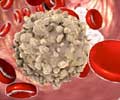Prognosis
Prognosis of the ALL patient depends on several parameters. Younger patients have better chances of survival compared to older ones.
Patients with ALL are divided into 3 prognostic groups-
Favorable prognosis group includes:
- No adverse cytogenetic abnormalities
- Age younger than 30 years
- WBC count of less than 30,000/µL
- Complete remission within 4 weeks.
Intermediate risk group does not meet the criteria for either good risk or poor risk.
Poor risk group includes:
- Adverse cytogenetics [(t9; 22), (4; 11) genetic translocations]
- Age older than 60 years
- Precursor B-cell WBCs with WBC count greater than 100,000/µL
- Failure to achieve complete remission within 4 weeks
Table 1-Correlation between cytogenetic abnormalities and prognosis
| Cytogenetic Abnormality | Genes Involved | Event-Free Survival (3 yrs) |
| t(10;14)(q24;q11) | HOX11/TCRA | 75% |
| 6q | Not Known | 47% |
| 14q11 | TCRA/TCRD | 42% |
| 11q23 | MLL | 18-26% |
| 9p | Not Known | 22% |
| 12 | TEL | 20% |
| t(1;19)(q23;p13) | PBX1/E2A | 20% |
| t(8;14)(q24;q23) t(2;8)(p12;q24) t(8;22)(q24;q11) | c-myc/IGH IGK/c-myc c-myc/IGL | 17% |
| t(9;22)(q34;q11) Philadelphia chromosome | bcr-abl | 5-10% |
| t(4;11)(q21;q23) | AF4-MLL | 0-10% |
Table 2. Correlation between Ploidy (Chromosome Number) and Prognosis
| Ploidy | Event-Free Survival(3 yrs) |
| Near tetraploidy | 46-56% |
| Diploidy(Normal karyotype) | 34-44% |
| Hyperdiploidy >50 | 32-59% |
| Hyperdiploidy 47-50 | 21-53% |
| Pseudodiploidy | 12-25% |
| Hypodiploidy | 11% |














hi my daughter , rashmi 5 year old female was admitted in a hospital with the c/o fever,and anemia diagnosed as a ALL ,B CELL,started chemotherapy there at the time of admission her haemoglobin is 4,platelet 10,000,peripheral smear shows blast presnt CSF NEGATIVE BONE MARROW NOT DONE induction chemotherapy started prednisolone oral inj.vincristine i.v 4 doses inj, daunorubicin 3 doses inj.L. asparaginase 8 doses IT ,methotrexate 3 times BONE MARRO DONE 3? BLAST SHOWS phase b inj.cyclophosphamide iv 2 time inj,cytarabine s/c [ arac] 4 days * 4 doses tab .6 mp 60 days IT METHOTREXATE 3 times tab.biotraxate RE INDUCTION PHASE tab.dexamethasone orally inj.vincristine iv 4 doses inj. dnr 4 doses inj.L .asparanginase 4 dose inj.cyclophosphamide 1 dose inj.cytarabine 2 dose it.methotrexate 2 doses BONE MARROW DONE SHOWS 3% BLASTS AND 5%LYMPHS CSF NEGATIVE given tab.6pm for one month review 20/8/2012 please given valuable comments how is the condition and what to do next?
DO A HEART PATIENT GET CLL OR ALL OR AML OR CML
Non of this has helped me with my research :/ my sister has leukemia and none of the stuff above is even close!!
i had ALL WEN I WAS 10. I was treated for a year and i was good for 10 years but i was diagnosed for ALL wen I WAS 20 . I was treated and i am okay now. is this possible?